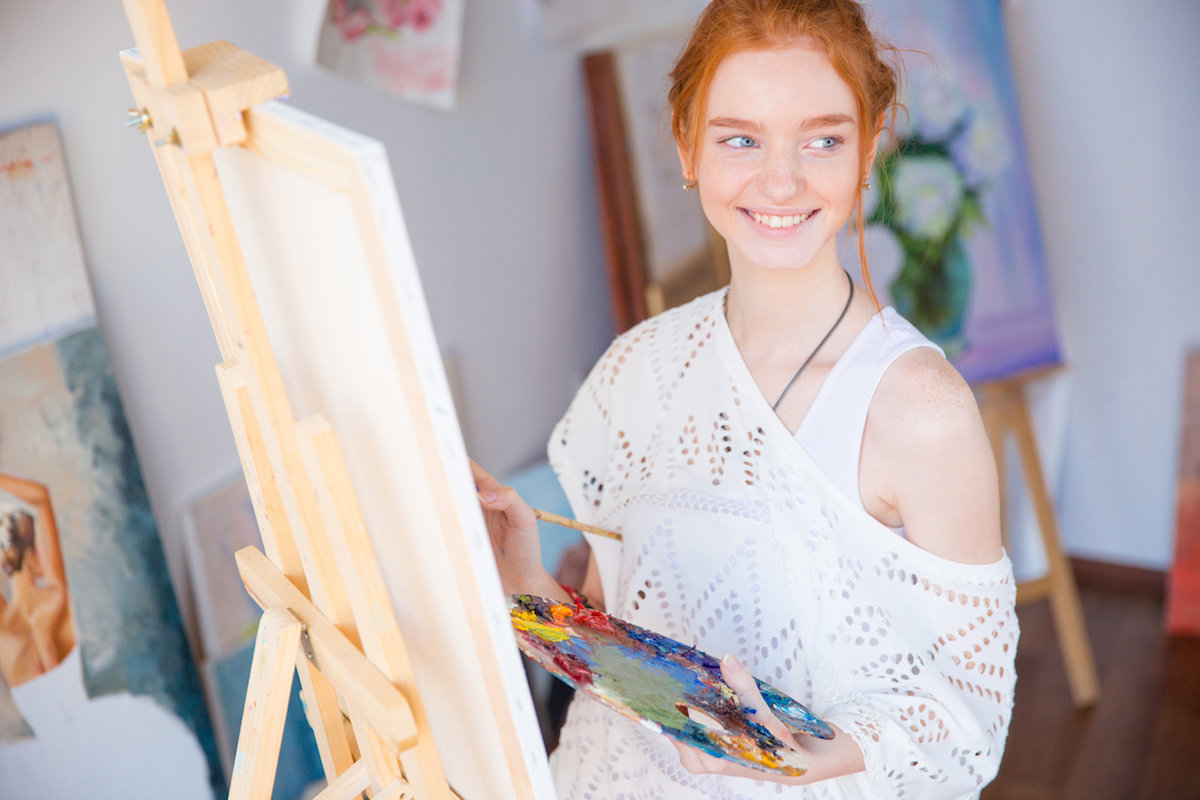
Let’s face it, when you are trying something new, whether it’s performing in front of an audience, writing, cooking, or even just giving a presentation for work, there is always the fear of exposure — or being plain downright rejected.
Negative messages we learn from others or feed to ourselves in these situations can take many forms. We tell ourselves we aren’t good enough at what we do. We compare ourselves to others and set standards that are impossible for anyone to achieve, let alone ourselves.
The art process is particularly vulnerable to self-criticism.
I’ve heard the typical put down lines over and over, such as, “my artwork doesn’t fit with what everyone else is doing so I must be doing something wrong” or “this looks like a 5-year-old could have done it”.
The list of self-defacing comments goes on. Heaven forbid we explore expressive line that doesn’t look like everyone else’s lines, or paint clouds purple. We crave freedom of expression, yet we put down our own uniqueness when trying to do so.
Whether from an art course you took in past, a comment that someone made, or even just having a bad day, it is the negative messages that we carry from our past that can easily block us when trying to learn. This negativity can be especially prominent when trying to learn how to draw or paint. And, it’s not just a beginner problem. Negative self-criticism gets worse as we get better at what we do.
Take for example accomplished artists who face the comments of the media every single day, including art critics. The other day I was visiting a Toronto artist at his studio who expressed frustration with the power of the word of the media (especially art critics) on determining the success or failure of an art exhibit.
When I asked him how he had endured some of the harsher comments of art critics through the years, he emphasized the need to follow your heart.
He confessed that as soon as you give in to try to please everyone else, including what people say or think about you, you will lose a part of yourself including your own artistic voice. Inner faith and integrity are everything for the artist, but how can art students start to explore their creative side and see their progress if they are bombarded by what is right and what is wrong right from the start? How can an artist move beyond negative self-criticism, so they can really start to see their own progress?
Negative self- criticism is something we learn early in our life. In fact, it often starts with a logical stage that children we go through as early as 10 years of age or even younger. For example, a child wants to draw an apple to look like an apple. If they can’t get the exact copy of what they are drawing they can get discouraged very quick. Needing to move towards a more positive frame of mind, especially in creating art, requires that you can’t be so logical that you try to copy something just to make it look right.
That is why I started a Drawing Basics course. I felt that adults needed a more innovative and non-judgemental gateway into the art-making process. That experience seems to depend on two factors. The first is learning to look at Abstract Art and second, having an Art Course Text as a supplement to the class.
What do we mean by Abstract art, and how does this very famous school that rebelled convention in the early 1900’s help to turn art students around in the way they perceive themselves and their art? I often start the course addressing this question through a series of short visual exercises. In one of these exercises, I show students a detail from a photo or a work of art and ask them to describe what they see. Take for example this photo:

Obviously, our logical side tells us what a rose should look like. We would assume that we would draw rose petals in familiar colors typical of a rose, including a green stem and green leaves. What if for a moment you were asked to look beyond the conventional description of a rose to draw or paint what you see in Abstract terms? For example, I came up with something like this after drawing and painting a blow up of the rose petal:

This is the kind of creative transformation I am talking about when I write about overcoming negative self-criticism.
Our art experience depends mostly on social convention or how we are expected or told to interpret what is around us. If you are told to copy a rose with green leaves, petals, and a stem, well, I guess that is what you think you ought to do.
On the other hand, imagine for a moment that seeing is quite personal and that everyone will see the same subject matter differently. Suddenly the typical logical rose we know it to be in our everyday life becomes an interesting orchestration of colours and shapes. It has expression and conveys emotion.
When you learn the visual skills needed to transform ordinary day-to-day subject matter into a series of lines, shapes, shadows, and colours, (as in my detail of a rose petal), you embrace a whole new creative direction that moves beyond the logical world of right or wrong.
The issue of using art to move beyond negative self-criticism is very important, so I created a student photocopy bound textbook to go along with the course (no tests or exam!). Overall, the message of the text is simple — a few paper and pencil step by step exercises combined with weekly classes. This can not only turn around the way you see your own artwork and the world around you but it can completely change the way you see yourself, hopefully for the better. It’s as simple as that.
A course textbook gives you that visual language as a springboard for creative self-expression and taking pride in your artwork.
Learning art is always this delicate balance between structure and freedom. It is this constant contradiction between a set of rules along with thinking outside the box that has challenged artists for centuries and one that makes teaching art so fascinating for me.
Hence, I call my text Breaking Beyond the Box to help artists move from the critical eye towards the constructive eye of the artist.
The fact that our culture is filled with stereotypes about how easy or hard an art class is does not help. We have become conditioned to think of the art process as some magical spell that we are born into. It is true that some have a natural talent over others. Perhaps artistic talent runs in the family or doesn’t. Some may have had more art education, and others, less.
Overall, artistic ability tends to be stigmatized as some mysterious result attributed to chance. It is easy to expect quick results and when we don’t get them, we blame ourselves. And yes, people can be highly creative, artistic, and talented and still have trouble drawing. In fact, the more bombarded we are by a world of facts, figures, and checkmarks, the further away we are from learning to make that shift into the artistic eye of the artist.
Art is a dynamic and progressive process that is always changing as you change. It is a process that will hopefully give you the conviction to embrace your own reality and transform that reality into something beautiful that lies beyond the world of logic or right and wrong.
In this non-judgemental artistic process, you find your own creative bliss because you learn to love your own capacity to be original rather than to reject it.
Remember — the act of drawing is not about filling the page, at least, not always right away. Regardless of the result you get on the paper, you need to exercise your visual muscles. If you exercise the right muscles, that is, look, look, look, enjoy quick sketches, accept happy accidents, and draw what speaks to you, you are already on your way to finding your own bliss.
With an open heart, a curious mind, and a more accepting attitude towards yourself, free of self-judgement, you’ll get there quicker than you realize.

We’d love to hear from you! Please send us your suggestions for future articles. And if you’re a writer, please see our writer’s submissions page for details.

